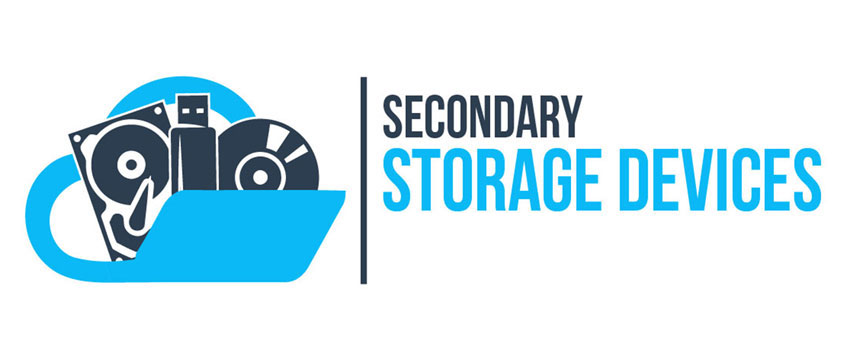Secondary storage -In old times, computers were used to solve complex problems. Owing to their huge size and complex architecture, no one ever thought to use them for data storage purposes. But with the developments in technological avenues, computer systems are now much more functional and handier.
One of the prime features of today’s computer is its capability of storing huge amounts of data. From storing important data to playing the heavy-duty games, all this is possible due to the huge storage mediums. Storage in a computer is referred by two terms, i.e. primary storage and secondary storage. Primary storage stores data for a short time frame when a computer is running. Random-Access Memory (RAM) and cache memory are examples of a primary storage medium.
Secondary storage is a non-volatile memory, which has the capability to hold data until and unless it has either been deleted or overwritten. It is also known as auxiliary storage, external memory, flash memory, and secondary memory. It must be noted that the prime function of the secondary storage is to compliment the primary storage. Besides that, it is also used as a backup storage medium just like cloud storage to protect from data loss due to computer malfunction, cyber-attack or any other tragedy. Generally, secondary storage technology is about two orders of magnitude cheaper than the primary storage.
Why Secondary Storage is so Important?
The reason why is secondary storage needed and so important lies in the volatile nature of the primary storage. Primary storage is basically a volatile type of memory where data is lost if the power goes off. In such situations, the user won’t be able to access or store its data for the retention period of his/her choice.
However, in the presence of a secondary storage device, data will be saved as long as it has neither been deleted nor overwritten. In this way, even if power is lost and all of the data on the primary storage has been lost, the user will still be able to recover the last saved version of the concerned file.
Types of Secondary Storage
Secondary storage devices have numerous types. Each of them has its own applications and relevance to a particular environment. Following are some of the popular types of secondary storage:
Hard Drive
A hard drive is such a secondary storage device that is used to permanently store and retrieve the data on a computer. It is also abbreviated as an HDD or HD. Its architecture involves one or more platters, on which data is usually written by the aid of a magnetic head and all this is enclosed within an air-sealed casing.
Typically, they are connected internally to the computer’s motherboard, through an ATA, SCSI or a SATA cable and are powered through the power supply unit. In addition to the internal connectivity, there are external hard drives too which can be connected externally to the subjected device through the USB connection.
Solid State Drive
Solid-state drives use non-volatile memory as a mean of holding and accessing data. Therefore, it does not use disk drives mechanism and is typically abbreviated as SSD. SSD does not have any moving part and this makes them different from the hard drives. On account of this, they offer much faster access, higher reliability, noiseless operation, and very low power consumption.
They typically use a SATA connection, having a maximum transfer rate of 750 MB per second. New generation SSD now connects to the motherboard’s PCIe port and offers transfer speed up to 1.5 GB per second. As their prices have drastically been improved over time, they are now the most suitable replacement for the hard drives in conventional laptops and desktops.
Universal Serial Bus
It is a portable secondary storage device and is often the size of a human thumb. It connects via the USB port of the computer. It is also known as the data stick, pen drive, keychain drive, thumb drive, and a USB flash drive. They are the easiest way to transfer data from one computer to another as well as an excellent device to store huge amount of data. They offer storage ranging between 2 GB and 1 TB.
USB flash drives do not have any moving parts. Instead, they have an integrated circuit, having an embedded memory chip to store data.
Optical Secondary Storage
CDs and DVDs are one of the most common and popular optical storage mediums. These disks have the ability to execute or retrieve data for later usage. They can even store software, save backup files as well as store music and videos.
A standard CD is capable of storing 650 MB of data or 72 minutes of music. Generally, 80 minutes of CD contains 700 MB of data. However, a standard DVD has the capability of storing much more data than that of a typical CD.
DVDs come in different storage capacities, starting from 4.7 GB to a maximum of 17.08 GB. It must be noted that there isn’t any significant difference between the CD and DVD, except the storage capacity.
Floppy Disk
It was first created by IBM in the year 1967, as an alternative to the hard drive. Floppy disks can store electronic data such as a document or any computer file. Since earlier computers did not have CD-ROM or USB port, so the floppy disk was the only way to store or read any file.
Generally, data up to 1.44 MB can be stored onto a 3.5” floppy disk. So, if data is larger than 1.44 MB, then multiple floppy disks are supposed to be used. However, since 2000 computers do not support floppy disks, but it doesn’t mean that their use has been obsolete. Instead many U.S government agencies still use 8” floppy disks to store their sensitive data.
Tape Drives
It is basically a magnetically coated, thin pieces of plastics that are wrapped around the wheel to store data. Though these magnetic tape drives offer much slower storage solution, still they are much cheaper than most of the storage mediums.
The first tape drive had a storage capacity of just 224 KB. But recently IBM released its 6th generation tape drives, having the storage capacity of 15 TB. Furthermore, zip disk is an advanced version of floppy disks.
https://backupeverything.co.uk/what-is-secondary-storage/




